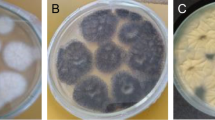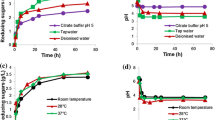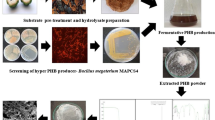Abstract
Polyhydroxyalkanoates are polyesters of R-hydroxyalkonic acids, prominently used as bioplastics on grounds of their complete biodegradable and environment-friendly characteristics. There is an upsurge in need of an alternative low-cost, renewable carbon source for the production of PHA for enhanced economic and to exert a positive impact on the industries. In the present work, cashew apple juice (CAJ) was supplemented as a carbon source for Cupriavidus necator to produce PHA. (NH4)2SO4, NH4Cl, NH4NO3 and CO(NH2)2, and NaNO3 were tested and urea was found to be the best nitrogen source that supports optimal growth of the microorganism. The production process was then optimized using response surface methodology by incorporating the effects of total reducing sugar concentration, urea concentration, and inoculum size. Under optimized condition, the resulting PHA yield was found to be 15.78 g/L with total reducing sugar concentration of 50 g/L, inoculum size of 50 mL/L, and urea concentration of 3 g/L. FT-IR, NMR, TGA, and DSC analysis revealed the product to be a copolymer of hydroxybutyrate and hydroxyvalerate.

Graphical abstract





Similar content being viewed by others
References
Ntaikou I, Koumelis I, Tsitsilianis C, Parthenios J, Lyberatos G (2018) Comparison of yields and properties of microbial polyhydroxyalkanoates generated from waste glycerol-based substrates. Int J Biol Macromol 112:273–283. https://doi.org/10.1016/j.ijbiomac.2018.01.175
Ahn J, Jho EH, Nam K (2016) Effect of acid-digested rice straw waste feeding methods on the 3HV fraction of bacterial poly(3-hydroxybutyrate-co-3-hydroxyvalerate) production. Process Biochem 51:2119–2126. https://doi.org/10.1016/j.procbio.2016.09.014
Reddy CS, Ghai R, Rashmi KV (2003) Polyhydroxyalkanoates: an overview. Bioresour Technol 87:137–146. https://doi.org/10.1016/S0960-8524(02)00212-2
Li Z, Yang J, Loh XJ (2016) Polyhydroxyalkanoates: opening doors for a sustainable future. NPG Asia Mater 8:e265–e220. https://doi.org/10.1038/am.2016.48
Muhammadi S, Afzal M, Hameed S (2015) Bacterial polyhydroxyalkanoates-eco-friendly next-generation plastic: production, biocompatibility, biodegradation, physical properties, and applications. Green Chem Lett Rev 8:56–77. https://doi.org/10.1080/17518253.2015.1109715
Ali I, Jamil N (2016) Polyhydroxyalkanoates: current applications in the medical field. Front Biol (Beijing) 11:19–27. https://doi.org/10.1007/s11515-016-1389-z
Shrivastav A, Kim H-Y, Kim Y-R (2013) Advances in the applications of polyhydroxyalkanoate nanoparticles for novel drug delivery system. Biomed Res Int 2013:1–12. https://doi.org/10.1155/2013/581684
Lee SY, Choi J (1998) Effect of fermentation performance on the economics of poly(3-hydroxybutyrate) production by Alcaligenes latus. Polym Degrad Stab 59:387–393. https://doi.org/10.1016/S0141-3910(97)00176-6
Ojha N, Das N (2018) A statistical approach to optimize the production of polyhydroxyalkanoates from Wickerhamomyces anomalus VIT-NN01 using response surface methodology. Int J Biol Macromol 107:2157–2170. https://doi.org/10.1016/j.ijbiomac.2017.10.089
Cui YW, Zhang HY, Ji SY, Wang ZW (2017) Kinetic analysis of the temperature effect on polyhydroxyalkanoate production by Haloferax mediterranei in synthetic molasses wastewater. J Polym Environ 25:277–285. https://doi.org/10.1007/s10924-016-0807-2
Kucera D, Pernicová I, Kovalcik A, Koller M, Mullerova L, Sedlacek P, Mravec F, Nebesarova J, Kalina M, Marova I, Krzyzanek V, Obruca S (2018) Characterization of the promising poly(3-hydroxybutyrate) producing halophilic bacterium Halomonas halophila. Bioresour Technol 256:552–556. https://doi.org/10.1016/j.biortech.2018.02.062
Haas C, El-Najjar T, Virgolini N et al (2017) High cell-density production of poly(3-hydroxybutyrate) in a membrane bioreactor. New Biotechnol 37:117–122. https://doi.org/10.1016/j.nbt.2016.06.1461
Aramvash A, Hajizadeh-Turchi S, Moazzeni-zavareh F, Gholami-Banadkuki N, Malek-sabet N, Akbari-Shahabi Z (2016) Effective enhancement of hydroxyvalerate content of PHBV in Cupriavidus necator and its characterization. Int J Biol Macromol 87:397–404. https://doi.org/10.1016/j.ijbiomac.2016.03.002
Yamada M, Yukita A, Hanazumi Y, Yamahata Y, Moriya H, Miyazaki M, Yamashita T, Shimoi H (2018) Poly(3-hydroxybutyrate) production using mannitol as a sole carbon source by Burkholderia sp. AIU M5M02 isolated from a marine environment. Fish Sci 84:405–412. https://doi.org/10.1007/s12562-017-1164-3
Bhatia SK, Shim YH, Jeon JM, Brigham CJ, Kim YH, Kim HJ, Seo HM, Lee JH, Kim JH, Yi DH, Lee YK, Yang YH (2015) Starch-based polyhydroxybutyrate production in engineered Escherichia coli. Bioprocess Biosyst Eng:38. https://doi.org/10.1007/s00449-015-1390-y
Arikawa H, Matsumoto K, Fujiki T (2017) Polyhydroxyalkanoate production from sucrose by Cupriavidus necator strains harboring CSC genes from Escherichia coli W. Appl Microbiol Biotechnol 101:7497–7507. https://doi.org/10.1007/s00253-017-8470-7
Kim BS (2000) Production of poly(3-hydroxybutyrate) from inexpensive substrates. Enzym Microb Technol 27:774–777. https://doi.org/10.1016/S0141-0229(00)00299-4
Kynadi AS, Suchithra TV (2017) Formulation and optimization of a novel media comprising rubber seed oil for PHA production. Ind Crop Prod 105:156–163. https://doi.org/10.1016/j.indcrop.2017.04.062
Cavalheiro JMBT, de Almeida MCMD, Grandfils C, da Fonseca MMR (2009) Poly(3-hydroxybutyrate) production by Cupriavidus necator using waste glycerol. Process Biochem 44:509–515. https://doi.org/10.1016/j.procbio.2009.01.008
Purama RK, Al-Sabahi JN, Sudesh K (2018) Evaluation of date seed oil and date molasses as novel carbon sources for the production of poly(3Hydroxybutyrate-co-3Hydroxyhexanoate) by Cupriavidus necator H16 Re 2058/pCB113. Ind Crop Prod 119:83–92. https://doi.org/10.1016/j.indcrop.2018.04.013
Pais J, Serafim LS, Freitas F, Reis MAM (2016) Conversion of cheese whey into poly(3-hydroxybutyrate-co-3-hydroxyvalerate) by Haloferax mediterranei. New Biotechnol 33:224–230. https://doi.org/10.1016/j.nbt.2015.06.001
Salgaonkar BB, Bragança JM (2017) Utilization of sugarcane bagasse by Halogeometricum borinquense strain E3 for biosynthesis of poly(3-hydroxybutyrate-co-3-hydroxyvalerate). Bioengineering 4:50. https://doi.org/10.3390/bioengineering4020050
Balakrishna Pillai A, Jaya Kumar A, Thulasi K, Kumarapillai H (2017) Evaluation of short-chain-length polyhydroxyalkanoate accumulation in Bacillus aryabhattai. Braz J Microbiol 48:451–460. https://doi.org/10.1016/j.bjm.2017.01.005
Norhafini H, Huong KH, Amirul AA (2019) High PHA density fed-batch cultivation strategies for 4HB-rich P(3HB-co-4HB) copolymer production by transformant Cupriavidus malaysiensis USMAA1020. Int J Biol Macromol 125:1024–1032. https://doi.org/10.1016/j.ijbiomac.2018.12.121
Ghosh S, Gnaim R, Greiserman S et al (2019) Macroalgal biomass subcritical hydrolysates for the production of polyhydroxyalkanoate (PHA) by Haloferax mediterranei. Bioresour Technol 271:166–173. https://doi.org/10.1016/j.biortech.2018.09.108
Zihayat B, Shakibaie M, Sabouri-Shahrbabak S et al (2019) Medium optimization for polyhydroxyalkanoate production by Pseudomonas pseudoalcaligenes strain Te using D-optimal design. Biocatal Agric Biotechnol. https://doi.org/10.1016/j.bcab.2019.01.039
Wijeyekoon S, Carere CR, West M et al (2018) Mixed culture polyhydroxyalkanoate (PHA) synthesis from nutrient rich wet oxidation liquors. Water Res 140:1–11. https://doi.org/10.1016/j.watres.2018.04.017
Liao Q, Guo L, Ran Y et al (2018) Optimization of polyhydroxyalkanoates (PHA) synthesis with heat pretreated waste sludge. Waste Manag 82:15–25. https://doi.org/10.1016/j.wasman.2018.10.019
Maheshwari N, Kumar M, Thakur IS, Srivastava S (2018) Production, process optimization and molecular characterization of polyhydroxyalkanoate (PHA) by CO2sequestering B. cereus SS105. Bioresour Technol 254:75–82. https://doi.org/10.1016/j.biortech.2018.01.002
De Grazia G, Quadri L, Majone M et al (2017) Influence of temperature on mixed microbial culture polyhydroxyalkanoate production while treating a starch industry wastewater. J Environ Chem Eng 5:5067–5075. https://doi.org/10.1016/j.jece.2017.09.041
Sawant SS, Tran TK, Salunke BK, Kim BS (2017) Potential of Saccharophagus degradans for production of polyhydroxyalkanoates using cellulose. Process Biochem 57:50–56. https://doi.org/10.1016/j.procbio.2017.03.016
Odeniyi OA, Adeola OJ (2017) International Journal of Biological Macromolecules Production and characterization of polyhydroxyalkanoic acid from Bacillus thuringiensis using different carbon substrates. Int J Biol Macromol 104:407–413. https://doi.org/10.1016/j.ijbiomac.2017.06.041
Blanky M, Sharaby Y, Rodríguez-martínez S, et al. (2017) Application of cider by-products for medium chain lenght polyhydroxyalkanoate production by Pseudomonas putida KT2440. doi: https://doi.org/10.1016/j.watres.2017.08.068
Koller M, Maršálek L, de Sousa Dias MM, Braunegg G (2017) Producing microbial polyhydroxyalkanoate (PHA) biopolyesters in a sustainable manner. New Biotechnol 37:24–38. https://doi.org/10.1016/j.nbt.2016.05.001
Das I, Arora A (2017) Post-harvest processing technology for cashew apple – a review. J Food Eng 194:87–98. https://doi.org/10.1016/j.jfoodeng.2016.09.011
Arumugam A, Ponnusami V (2015) Ethanol production from cashew apple juice using immobilized saccharomyces cerevisiae cells on silica gel matrix synthesized from sugarcane leaf ash. Chem Eng Commun 202:709–717. https://doi.org/10.1080/00986445.2013.867256
Betiku E, Emeko HA, Solomon BO (2016) Fermentation parameter optimization of microbial oxalic acid production from cashew apple juice. Heliyon 2:e00082. https://doi.org/10.1016/j.heliyon.2016.e00082
López-Abelairas M, García-Torreiro M, Lú-Chau T, Lema JM, Steinbüchel A (2015) Comparison of several methods for the separation of poly(3-hydroxybutyrate) from Cupriavidus necator H16 cultures. Biochem Eng J 93:250–259. https://doi.org/10.1016/j.bej.2014.10.018
Dias JML, Serafim LS, Lemos PC, Reis MAM, Oliveira R (2005) Mathematical modeling of a mixed culture cultivation process for the production of polyhydroxybutyrate. Biotechnol Bioeng 92:209–222. https://doi.org/10.1002/bit.20598
Owolabi RU, Usman MA, Kehinde AJ (2018) Modelling and optimization of process variables for the solution polymerization of styrene using response surface methodology. J King Saud Univ Sci 30:22–30. https://doi.org/10.1016/j.jksues.2015.12.005
Impallomeni G, Ballistreri A, Carnemolla GM, Rizzo MG, Nicolò MS, Guglielmino SPP (2018) Biosynthesis and structural characterization of polyhydroxyalkanoates produced by Pseudomonas aeruginosa ATCC 27853 from long odd-chain fatty acids. Int J Biol Macromol 108:608–614. https://doi.org/10.1016/j.ijbiomac.2017.12.037
Guo W, Duan J, Geng W, Feng J, Wang S, Song C (2013) Comparison of medium-chain-length polyhydroxyalkanoates synthases from Pseudomonas mendocina NK-01 with the same substrate specificity. Microbiol Res 168:231–237. https://doi.org/10.1016/j.micres.2012.11.003
Ng K-S, Ooi W-Y, Goh L-K, Rajaiah Shenbagarathai KS (2010) Evaluation of jatropha oil to produce poly(3-hydroxybutyrate) by Cupriavidus necator H16. Polym Degrad Stab 95:1365–1369. https://doi.org/10.1016/j.polymdegradstab.2010.01.021
Nygaard D, Yashchuk O, Hermida ÉB (2019) Evaluation of culture medium on poly(3-hydroxybutyrate) production by Cupriavidus necator ATCC 17697: application of the response surface methodology. Heliyon 5:e01374. https://doi.org/10.1016/j.heliyon.2019.e01374
Murugan P, Gan C-Y, Sudesh K (2017) Biosynthesis of P(3HB-co-3HHx) with improved molecular weights from a mixture of palm olein and fructose by Cupriavidus necator Re2058/pCB113. Int J Biol Macromol 102:1112–1119. https://doi.org/10.1016/j.ijbiomac.2017.05.006
Chandani Devi N, Mazumder PB, Bhattacharjee A (2018) Statistical optimization of polyhydroxybutyrate production by Bacillus Pumilus H9 using cow dung as a cheap carbon source by response surface methodology. J Polym Environ 26:1–9. https://doi.org/10.1007/s10924-018-1194-7
Arumugam A, Senthamizhan SG, Ponnusami V, Sudalai S (2018) Production and optimization of polyhydroxyalkanoates from non-edible Calophyllum inophyllum oil using Cupriavidus necator. Int J Biol Macromol 112:598–607. https://doi.org/10.1016/j.ijbiomac.2018.02.012
Mostafa NA, Farag AA, Abo-dief HM, Tayeb AM (2018) Production of biodegradable plastic from agricultural wastes. Arab J Chem 11:546–553. https://doi.org/10.1016/j.arabjc.2015.04.008
Verlinden RAJ, Hill DJ, Kenward MA, Williams CD, Piotrowska-Seget Z, Radecka IK (2011) Production of polyhydroxyalkanoates from waste frying oil by Cupriavidus necator. AMB Express 1:11. https://doi.org/10.1186/2191-0855-1-11
Funding
This study is financially supported by SERB (Science & Engineering Research Board), India (Grant No. ECR/2017/ 001038/2017-2018) to carry out this research work.
Author information
Authors and Affiliations
Corresponding author
Ethics declarations
Conflict of interest
The authors declare that they have no conflict of interest.
Additional information
Publisher’s note
Springer Nature remains neutral with regard to jurisdictional claims in published maps and institutional affiliations.
Rights and permissions
About this article
Cite this article
Arumugam, A., Anudakshaini, T.S., Shruthi, R. et al. Low-cost production of PHA using cashew apple (Anacardium occidentale L.) juice as potential substrate: optimization and characterization. Biomass Conv. Bioref. 10, 1167–1178 (2020). https://doi.org/10.1007/s13399-019-00502-5
Received:
Revised:
Accepted:
Published:
Issue Date:
DOI: https://doi.org/10.1007/s13399-019-00502-5




